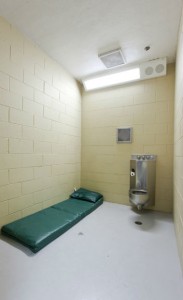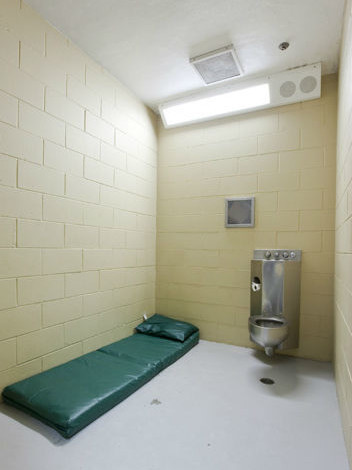
Isolation cell at the Fairbanks Youth Facility Fairbanks AK. Photo by Richard Ross
CHICAGO -- Even as national organizations rallied this week to end solitary confinement for incarcerated juveniles across the country, the local branch of American Civil Liberties Union is working with prison officials and the federal court to focus on the issue here.
The goal: settle a lawsuit on behalf of 2,217 incarcerated youth with the Illinois Department of Juvenile Corrections over the system’s inadequate services and often-hostile environment.
A preliminary agreement calls for curbing the growing practice of solitary confinement in youth centers, which activists say constitutes “torture,” given its potential for causing long-lasting psychological harm.
The proposed settlement, which is due for a fairness hearing in federal court in Chicago on December 6, would be the latest victory in a larger movement to end the punitive isolation of youth in custody. In June, Congress held its first hearing on the issue of solitary confinement within U.S. prisons, where roughly 80,000 inmates are in “restricted housing“ at any given time nationwide, according to a 2005 census of adult inmates by the federal Bureau of Justice Statistics.
Long a focus of the adult prison reform movement, advocates say the practice is even more damaging to emotionally developing juvenile offenders.
Solitary confinement should be reserved for violent offenses, such as fighting or attacking a guard, according to federal law. But investigations of Illinois’ juvenile facilities conducted by the Juvenile Justice Project at the John Howard Association found that youth were frequently isolated for non-violent offenses. Juvenile offenders have been separated for transgressions as minor as eating a guard’s food.
Prison staff often separate youth on the charge of “intimidation,” which John Howard Association of Illinois noted lacked any formal definition. According to the prison reform organization, youth in custody are subject to “a lottery of sorts,” in which their punishment often relies on the guard’s disposition.
ACLU settlement doesn’t call for outright abolishment of solitary confinement, but rather clarification of what constitutes an offense punishable by isolation. ACLU-Illinois Senior Counsel Adam Schwartz, for example, said there might arise rare instances where a juvenile is violent or physically out of control and in need of a short “time-out.”
Joshua Delaney of the Department of Justice, Civil Rights Division, said some prisons also place youth in solitary confinement when they first arrive as a hopeful deterrent for future misbehavior.
“At one facility, approximately 20 percent of youth were housed in isolation on any given day, and denied essential programming, services and recreation,” Delaney said during a recent online gathering of juvenile justice officials and advocates, hosted by the National Center for Youth in Custody.
“Part of the problem stemmed from the bizarre facility practice of routinely isolating incoming residents for a number of days,” he said, “reportedly for the purpose of determining whether each new youth would pose a threat to the facility.”
Activists also discovered that non-offending youth are sometimes placed in solitary confinement as a means to protect them from potential abuse or harassment at the hands of other inmates.
A 2011 visit to Illinois Youth Center St. Charles found that because of its inadequate infirmary, injured or sick youth were being housed in solitary confinement. After a Juvenile Justice Project report on the problem, the center now sends their sick youth to a nearby youth facility with adequate health care.
Other recent efforts may help curb the practice of “protective” isolation. It is common for facilities to house gay and transgender youth separately in order to prevent physical or verbal victimization by other juvenile inmates. But according to a recent study on LGBTQ youth in custody by the policy think tank Center for American Progress, the practice further marginalizes the potential victim.
“This isolation perpetuates the stigmatization of gay and transgender youth, casts them as sexually deviant, and signals that they might be of threat to other youth,” according to the report. Rules for complying with the Prison Rape Elimination Act, issued in late August, have outlawed this practice.
A 2006 Washington University report found that solitary confinement can lead to trauma, psychosis and aggression among youth. Half of all suicides that take place within juvenile detention centers happen within solitary confinement. Roughly 65 percent of young people who committed suicide had a history of separation. ACLU and Human Rights Watch released a joint report documenting the frequent use of solitary confinement of juveniles Wednesday.
U.N. Special Rapporteur on torture Juan E. Méndez called for a ban on solitary confinement of young people and inmates with mental illness in 2011. “Considering the severe mental pain or suffering solitary confinement may cause… it can amount to torture or cruel, inhumane or degrading treatment or punishment when used as a punishment… for persons with mental disabilities or juveniles,” he said in a statement before the U.N. General Assembly.
Advocates hope a combination of international human rights pressure and local legislation will force American detention centers to rethink isolation of young offenders.
“There’s movement both on the congressional level and on the state level,” said Baher Azmy, legal director for Center for Constitutional Rights.
The center has led several lawsuits against solitary confinement, most recently in Pelican Bay, Calif. Azmy said focusing on youth may motivate legislators to stand up and address the issue of isolation.
“The important thing is to use litigation in combination with organization, media and legislative advocacy” said Azmy.
Photo by Richard Ross.
Story from The Chicago Bureau.
